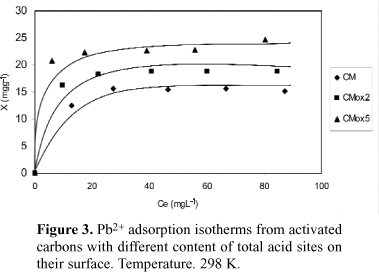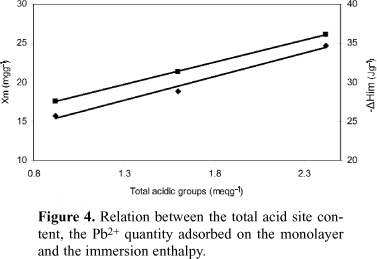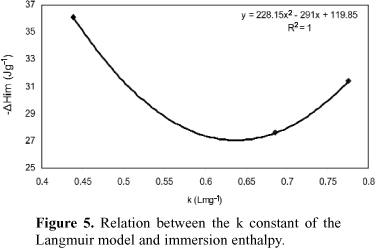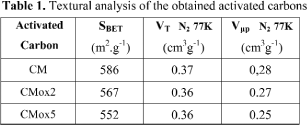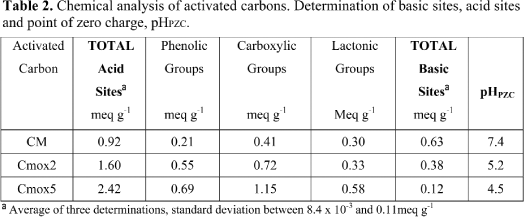Abstract
An activated carbon was obtained by chemical activation with phosphoric acid, CM, from a mineral carbon. Afterwards, the carbon was modified with 2 and 5 molL-1, CMox2 and CMox5 nitric acid solutions to increase the surface acid group contents. Immersion enthalpy at pH 4 values and Pb2+ adsorption isotherms were determined by immersing activated carbons in aqueous solution. The surface area values of the adsorbents and total pore volume were approximately 560 m².g-1 and 0.36 cm³g-1, respectively. As regards chemical characteristics, activated carbons had higher acid sites content, 0.92-2.42 meq g-1, than basic sites, 0.63-0.12 meq g-1. pH values were between 7.4 and 4.5 at the point of zero charge, pH PZC. The adsorbed quantity of Pb2+ and the immersion enthalpy in solution of different pH values for CM activated carbon showed that the values are the highest for pH 4, 15.7 mgg-1 and 27.6 Jg-1 respectively. Pb2+ adsorption isotherms and immersion enthalpy were determined for modified activated carbons and the highest values were obtained for the activated carbon that showed the highest content of total acid sites on the surface.
immersion enthalpy; Pb2+ adsorption; Langmuir isotherm; surface-modified
Immersion enthalpy variation of surface-modified mineral activated carbon in lead (II) aqueous solution adsorption: the relation between immersion enthalpy and adsorption capacity
L. GiraldoI; J.C. Moreno-PirajánII
IDepartment of Chemistry. School of Sciences. Universidad Nacional de Colombia
IIDepartment of Chemistry. School of Sciences. Universidad de los Andes. Colombia
ABSTRACT
An activated carbon was obtained by chemical activation with phosphoric acid, CM, from a mineral carbon. Afterwards, the carbon was modified with 2 and 5 molL-1, CMox2 and CMox5 nitric acid solutions to increase the surface acid group contents. Immersion enthalpy at pH 4 values and Pb2+ adsorption isotherms were determined by immersing activated carbons in aqueous solution. The surface area values of the adsorbents and total pore volume were approximately 560 m2.g-1 and 0.36 cm3g-1, respectively. As regards chemical characteristics, activated carbons had higher acid sites content, 0.92-2.42 meq g-1, than basic sites, 0.63-0.12 meq g-1. pH values were between 7.4 and 4.5 at the point of zero charge, pHPZC. The adsorbed quantity of Pb2+ and the immersion enthalpy in solution of different pH values for CM activated carbon showed that the values are the highest for pH 4, 15.7 mgg-1 and 27.6 Jg-1 respectively. Pb2+ adsorption isotherms and immersion enthalpy were determined for modified activated carbons and the highest values were obtained for the activated carbon that showed the highest content of total acid sites on the surface.
Keywords: immersion enthalpy; Pb2+ adsorption; Langmuir isotherm; surface-modified.
Introduction
In a system where the adsorbate, that is a dissociated or protonated electrolyte, is under conditions in which the adsorption takes place; electrostatic interactions are produced, strongly influencing the metallic ions adsorption on activated carbons. Such interactions may be attractive or repulsive, depending on the adsorbent charge densities, ionic strength of the solution and kind of adsorbate [1].
The surface charge on the activated carbons is associated with the existence of heteroatoms and mainly, with the oxygen complexes content. Therefore, when an activated carbon is submerged in water, a charge produced by the dissociation of its functional groups occurs on its surface [2]. The adsorption of heavy metals in carbonaceous materials thus mainly occurs in the acid sites, such as lactonic and carboxylic groups [3,4].
Among the heavy metal ions, Pb2+ is considered highly toxic and is kept in aqueous solution because of its ability to form complexes with the organic matter; therefore, the way in which this compound may be extracted from water using adsorbents and the factors that hinder such union are studied [5,6]. It is useful to study the energetic interactions occurring between the activated carbon and the surrounding aqueous solution by means of immersion enthalpy, because the metal adsorption from the solution shows the significant influence of the solvent that also occupies the available adsorption sites on solid surface. Consequently, the solution components reach an equilibrium where they interact in conjunction with the solid [7].
In this work, an activated carbon was prepared from mineral carbon, CM, and chemically activated with phosphoric acid, and Pb2+ adsorption isotherms, taken from aqueous solutions at different pH values were determined. Immersion enthalpies were also determined from activated carbon in order to establish relations with the adsorption parameters. Afterwards, two samples of activated carbon were obtained and their chemical surfaces were modified by oxidation with HNO3 2 and 5 molL-1, CMox2 and CMox5 solutions. Adsorption isotherms at a fixed pH and immersion enthalpies were then determined for these solutions.
Experimental details
Previous treatment of the initial material
The original mineral carbon was milled and sieved at an average particle size of 0.551 mm in order to obtain granular activated carbons. The material was then washed with distilled water, dried for 24 hours in an oven at 363 K and stored in dry plastic packages.
Obtaining activated carbon through chemical activation
For chemical activation, bituminous mineral carbon from the northern region of Colombia was taken and impregnated with a H3PO4 at 50% v/v solution for 1 hour. The impregnated samples were then air dried at a temperature of 383 K for 4 hours. The activation process was carried out during 2 hours at 723 K and heating ramp of 10 Kmin-1. A N2 200 mLmin-1 flow was maintained. Samples were then washed using distilled water until a conductivity of 5 µS cm-1 was obtained for the water used.
When activated carbons are chemically prepared, one of the compounds usually used as activator is the phosphoric acid, since its dehydrating properties that enable it to react with the carbonaceous material and modify the carbonization process. Additionally, phosphoric acid introduces in the precursor and avoids its contraction during the heating, leaving spaces when it is removed in a later stage with washes. This way, generation of higher pore content takes place.
Modification of the chemical surface with HNO3 solutions
Quantities of approximately 5.000 g of activated carbon were taken and placed in contact with 50.0 mL of 2 and 5 molL-1 nitric acid solutions at 323 K. The samples were constantly stirred for a 1-h period [10], washed with distilled water to achieve a near neutral pH and dried in a stove at 343 K.
Textural analysis of the activated carbons obtained
Textural characteristics were established through the determination of the N2 adsorption isotherms at 77 K in a conventional volumetric machine, Autosorb 3B, Quantachrome.
Determining active sites
Basic and acid sites of activated carbons were determined by the Boehm's method [11]. Acid sites were neutralized with a NaOH 0.1 molL-1 solution and basic sites with a HCl 0.1 molL-1 solution. Carboxylic and lactonic sites were titrated with a Na2CO3 0.1 molL-1 solution, carboxylic sites with a Na2CO3. 0.1 molL-1 solution and phenolic sites were estimated by calculating the difference [12]. For the determinations, 50 mL of the solution was placed into contact with 1.000 g of activated carbon in a glass flask for 5 days at a constant temperature of 298 K. 10 mL was titrated using a 0.1 molL-1 of the corresponding solution. Measurements for titting were performed using a CG 840B Schott pH meter.
Determining the point of zero charge, PZC. Mass Titting method
Activated carbons ranging 10 to 600 mg were taken. Each was placed in a 50.0 mL glass flask and 10.0 mL of sodium chloride, NaCl, (0.1 molL-1) was added,. Flasks were sealed and stirred and room temperature was maintained at 298 K for 48 hours to achieve equilibrium in carbon charges. After 48 hours, pH of each solution was measured with a CG 840B Schott pH meter [13].
Pb2+ adsorption equilibrium data
Pb2+ solutions were prepared from Pb(NO)3 within a concentration range of 20 to 100 mgL-1 and the pH value was adjusted to 2, 4, 6 and 8, depending on the case, with solutions of HCl 0.01 molL-1 and NaOH 0.01 molL-1. A quantity of 0.100 to 0.250 g of activated carbon obtained from the mineral carbon, CM, was placed in a glass flask containing 250 mL of the corresponding Pb2+ solution. The solution was stirred and kept at 298 K to achieve equilibrium in carbon charges.
Pb2+ concentration in aqueous solution was determined by atomic absorption using a Perkin-Elmer AAnalyst 300 and evaluation was performed using calibration curves [7]. Calibration curves were prepared for all of the pH values tested in this work.
Once the maximum adsorption pH was chosen for the initial activated carbon, CM, isotherms were determined at 298 K and this pH value for the modified activated carbon samples CMox2 and CMox5.
Determining immersion heats
In order to determine the immersion enthalpy a heat conduction microcalorimeter with a stainless calorimetric cell was used [14]. The cell was filled with 30 mL of the chosen solution, Pb2+ 100 mgL-1, (kept in a thermostat) at 298 K at a fixed pH. A sample of activated carbon weighing approximately 0.250 g was placed in a calorimetric cell inside a glass ampoule and the microcalorimeter was assembled. When the equipment reached a temperature of 298 K, the potential output record began. This lasted for a period of approximately 15 minutes with potential reading taken every 20 seconds. The glass ampoule was then broken; the thermal effect generated was recorded and the readings corresponding to the potential continued for approximately 15 more minutes until, finally, it was electrically calibrated.
Results and Discussion
For the mineral carbon used as a precursor, a fixed carbon content of 58% was found. This was a good choice for an initial material in order to obtain an activated carbon because after the thermal treatment of the final activated carbons, the fixed carbon contents will increase [15]. The volatile matter was approximately 29% and the ash content, 5.5%. These values agree previous studies in which a mineral carbon was used as a precursor. Such contents have a subsequent influence on the development of the porosity for the obtained activated carbon. [16].
Table 1 shows the results obtained when the textural analysis was performed for the prepared activated carbons. The surface area was determined by the BET method, SBET in m2g-1; total pore volume, VT, in cm3g-1 and the micropore volume, Vµp, in cm3g-1.
From results shown in Table 1 it may be seen that the chemical activation process is efficient because it activates for a 2-h period at a moderate temperature of 723 K. The burning rate was about 40% higher than the obtained under such conditions in physical activation; likewise, both the surface area, 586 m2g-1, and the pore volume present higher values than the ones reported in scientific literature for the activation of carbonaceous materials through the physical activation method [17]. In addition, for activated carbons that use mineral carbons as precursors, higher performance is obtained since they present greater carbon contents. However, in some cases, there are higher ash contents than in vegetable materials that may affect the activation process [16].
For the activated carbon samples treated with HNO3, slightly lower values were reported both for the surface area and micropore volume. These results agree with other studies reported in the literature [10] and may be associated with the elimination of the porosity in the original activated carbon.
Table 2 shows the results of the contents of the surface functional groups on the activated carbons with the number of total acid sites, in meqg-1. To chart results, the number of phenolic groups, carboxylic groups and lactonic groups were determined. The content of total basic sites and the pH at the point of zero charge are also shown. As it can be seen, the acid site content is higher than the basic site content for the three samples, with values ranging between 0.92 and 2.42 meqg-1. Such results show the modification in the contents of the surface acid group when the original activated carbon, CM, is treated with nitric oxide. Likewise, it was observed that the carboxylic acid-type groups are predominant; this characteristic boosts the adsorption of charged solutes from the aqueous solution. As regards the values for the pHPZC, for the original activated carbon, CM, a value of 7.4 is reported and for the other two samples, this value decreases with the increase of the surface acid sites content. Therefore, the activated carbon charge will be positive for a solution pH lower than the pHPZC l [1].
After determining the characteristics of the activated carbons, the adsorption isotherms were performed at different pH values, 2 to 8, for the unaltered activated carbon, CM. This was done to determine the maximum adsorption pH value and to subsequently obtain isotherms for the unmodified activated carbons CMox2 and CMox5 for the pH value.
The adsorption isotherms of activated carbon CM at different pH values of the solution are graphed in Figure 1; the figure displays the Pb2+ quantity adsorbed per gram of activated carbon in function of equilibrium concentration.
It can be seen that the Pb2+ ion adsorption in the CM activated carbon is high for pH 4, intermediate for pH 6 and 8, and low at pH 2. These liquid phase isotherms are of the Langmuir type, which are common when the adsorption of a solute in diluted solutions is studied [18].
Figure 2 shows the typical thermograms obtained when the activated carbons CM and CMox5 are immersed in a Pb2+ ion 100 mgL-1 solution. In this figure, heat is proportional to the area under the slope and a higher effect can be observed when the treated sample is immersed in a 5 M HNO3 solution.
Table 3 displays the results obtained for the ion metallic adsorption on the initial activated carbon, CM, at different pH values for the de Pb2+ quantity adsorbed in the monolayer, Xm, in mgg-1, the adsorption constant, k in Lmg-1 and the activated carbon immersion enthalpy in a solution of 100 mgL-1, DHim in Jg-1.
The maximum values are observed for the adsorption and immersion enthalpy at pH 4, which indicates that under such experimental conditions, the interaction between the activated carbon CM and the aqueous solution varies when pH values change. The lowest interaction was observed at pH 2, a behavior similar to that of carbonaceous materials reported in scientific literature [18]. According to the Pb2+ speciation diagram, these are the dominant species at a pH above 4: Pb(OH)+, Pb(OH)2, Pb(OH)42- and Pb(OH)3-. In acid media, the surface of solid is protonated and adsorption occurs in hydroxylated forms of lead. With the pH increase, the protonation of the carbon surface is gradually reduced and a decrease in the adsorption is observed. The pb2+ adsorption depends on the surface characteristics of the activated carbon, such as surface area and pore volume. In the present study, it may be seen that both properties are similar and there is a considerable variation in the acid groups content influencing the quantity adsorbed on the monolayer, Xm. Thereby, the highest value for CMox5, 24.6 mgg-1, has the highest content of total acid groups.
From the shown results, it can be seen that at pH 4, the highest Pb2+ adsorption is observed and this value is taken as a basis to determine the isotherms at 298 K for the chemically modified carbons, in which the total increase of acid sites increased. Therefore, the interaction between the solid and the solution will be influenced. Figure 3 shows the isotherms obtained for the three carbons activated in this study. The Pb2+ adsorption increased for the activated carbon CMox5, which has the highest content of the total acid sites.
Table 4 summarizes the results for the adsorption and Pb2+ immersion enthalpy on the activated carbons CM, CMox2 and CMox5 at pH 4. Again, the Langmuir model is applied to experimental data. The table displays the quantity adsorbed in the monolayer, Xm, in mgg-1; the adsorption constant, k, in Lmg-1 and the activated carbon immersion enthalpy in a solution of 100 mgL-1, DHim, in Jg-1.
It is observed that the interaction between the solid and the solution rises with the increase of the acid site content, which is expressed by the adsorption of a higher quantity, 24.6 mgg-1, and an increased immersion enthalpy of 36.1 Jg-1 for the activated carbon CMox5. Even if higher values are observed for the lactonic, carboxylic and phenolic groups, as well as for the modified activated carbons, carboxylic groups present the highest increase rate and they are supposed to boost the interaction.
Figure 4 shows the interactions between the total acid site content and the Pb2+ quantity adsorbed in the monolayer and immersion enthalpy for the activated carbons. In both cases, the tendencies are linear, with correlation coefficients of 0.98 and 0.99 respectively. This indicates that the increase in the surface acid site content boosts the interaction with the metallic ion.
The k constant obtained in the Langmuir model is related to the interaction produced in the adsorption process [15], as the k constant represents the immersion enthalpy of the solid in the solution. The relation between these values is shown in Figure 5, in which a non-linear tendency is observed for the three experimental points. This validates the existing relation between both characteristics established in Pb2+ adsorption from the aqueous solution on activated carbons.
In the aqueous solution, the solid-liquid interaction is influenced by the charge, both from the solid and the solutes that are dissociated. In this case, the solid surface charge is represented in the pH of the point of zero charge, pHPZC. Thus, there is a relationship among such value, the Pb2+ adsorbed quantity on the monolayer and the immersion enthalpy, as shown on Figure 6.
The experiment showed similar relationships, indicating the way in which the adsorbed quantity and immersion enthalpy are influenced by the surface solid properties, in addition to their surface area and pore volume. To notice this influence, it is important to keep in mind that metallic ion adsorption on the activated carbon depends on the surface characteristics, such as surface area, pore structure and surface acidity and solutions properties. For the systems studied, the activated carbons show surface areas of about 560 m2g-1, which were similar for the three samples, and an acid group content of 0.92 and 2.42 meqg-1. Pb2+ adsorption capacity shows a higher influence of the surface group content.
Conclusions
An activated carbon was obtained from the mineral carbon prepared by means of chemical activation and the surface properties of this carbon are adequate for the liquid-phase adsorption. The activated carbon was superficially modified using nitric acid and in all cases, the total acid sites content was higher than the content of the total basic sites.
For the original sample, adsorption isotherms were determined at 298 K at different pH values, and the highest adsorption and immersion enthalpy appeared at pH 4. The isotherms and quantities of adsorbed Pb2+ represent the major evidence of the influence of the solution conditions in the adsorption process.
The samples of modified activated carbons presented higher values for the adsorbed quantity on the monolayer and for the immersion enthalpy with respect to the original activated carbon. These are directly proportional to the number of total acid sites.
Acknowledgements
The authors wish to thank the Master Agreement established between the "Universidad de los Andes" and the "Universidad Nacional de Colombia" and the Memorandum of Understanding entered into by the Departments of Chemistry of both universities.
Received 12 September 2006
Accepted 08 November 2006.
- [1] C. Moreno-Castilla, Carbon 42 (2004) 83-94.
- [2] L. R. Radovic, C. Moreno-Castilla, J. Rivera-Utrilla, In: Chemistry and Physics of Carbon, A Series of Advances, Ed Marcel Dekker, New York, 2000, 293-297.
- [3] Y. Kikuchi, Q. Quian, M. Machida, H.Tatsumoto, Carbon 44 (2006) 195-202.
- [4] M. Machida, Y. Kikuchi, M. Aikawa, H. Tatsumoto, A: Physicochem Eng Aspects, Colloids Surf 240 (2004) 79-86.
- [5] A. Macias-García, C. Valenzuela-Calahorro, A. Espinosa-Mansilla, A. Bernalte-Garcia, B. Gómez-Serrano, Carbon 42 (2004) 1755-1764.
- [6] M. Fan, T. Boonfueng,Y. Xu, L. Axe, T. A. Tyson, J. Colloid of Interface Science 281 (2005) 39-48.
- [7] L.Giraldo, J. C. Moreno, Revista Colombiana de Química 33(2) (2004) 87-97.
- [8] F. Rodríguez-Reinoso, Encyclopedia of Materials, Science and Technology, New York, 2001, 22-30.
- [9] M.C. Baquero, L. Giraldo, J. C. Moreno, F. Suárez-García, A. Martínez-Alonso, J. Tascón JMD, Appl. Pyrolysis 70 (2003) 779-784.
- [10] A. Abdel-Naser, Hendawy-El, Carbon 41 (2003) 713-722.
- [11] H.P. Boehm, Advances in Catalysis, D.D. Eley, H. Pines, P.B.Weisz, Eds. Academic Press. New York., 1966,192-200.
- [12] F.S. Mohamed, W.A. Khater, M.R. Mostafa, Chem. Eng. Journal 116 (2006) 47-52.
- [13] M. Kosmulski, J. Colloid. Inter. Scien. 275 (2004) 214-224.
- [14] L.Giraldo, J.C. Moreno, J.I.Huertas, Instrumentation Science & Technology. 30(2) (2002) 177-186.
- [15] F. Rodríguez-Reinoso, Activated carbon: structure, characterization, preparation and applications. En: Introduction to carbon technologies. Universidad de Alicante (Publicaciones). Alicante, España.,1997, 60-70.
- [16] A. Linares-Solano, J. Martín-Gullon, C. Salinas-Martínez de Lecea, B. Serreno-Talavera, Fuel 79 (2000) 635-643.
- [17] M. A.Lillo-Ródano, D. Lozano-Castelló, D. Cazorla-Amorós, A. Linares-Solano, Carbon 39 (2001) 751-759.
- [18] K. Laidler, J.Meiser, Fisicoquímica, Ed. Cecsa, México, ed 2th , 2002, 234-260.
Publication Dates
-
Publication in this collection
27 Feb 2007 -
Date of issue
2006
History
-
Accepted
08 Nov 2006 -
Received
12 Sept 2006




